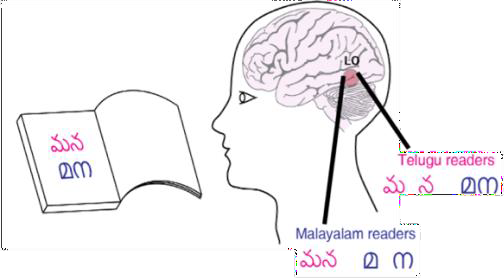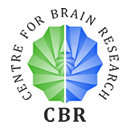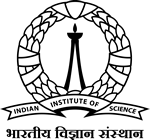Research Highlights related to Neuroscience
Reading Increases the Compositionality of Visual Word Representations
The study provided evidence that word responses are more predictable from single letter responses using experiments that compared nonoverlapping groups of readers of two Indian languages (Telugu and Malayalam). In brain-imaging experiments, we observed increased compositionality in readers, whereby responses to bigrams were more predictable from single letters. This effect was specific to the anterior lateral occipital region, where activations best matched behavior.


A Agrawal, K. V. S. Hari, SP Arun, “Reading Increases the Compositionality of Visual Word Representations,” Psychological Science, Nov 2019
A compositional neural code in high-level visual cortex can explain jumbled word reading
We read jubmled wrods effortlessly and we hypothesized that viewing a jumbled word activates a visual representation that is compared to known words. Brain imaging revealed that viewing a string activates this letter-based code in the lateral occipital (LO) region and that subsequent comparisons to stored words are consistent with activations of the visual word form area (VWFA). Thus, a compositional neural code potentially contributes to efficient reading.


Aakash Agrawal, K. V. S. Hari, SP Arun, “A compositional neural code in high-level visual cortex can explain jumbled word reading,”Elife,(9),pp. e54846,May 2020
Letter processing in upright bigrams predicts reading fluency variations in children.
To investigate if any aspects of visual orthographic processing also explain reading fluency beyond phonology, we tested primary school children on four tasks: two reading fluency tasks (word reading and passage reading), a Rapid Automatized Naming (RAN) task to measure naming speed, and a visual search task using letters and bigrams. As expected, the RAN score was strongly correlated with reading fluency. Importantly, there was a highly specific association between reading fluency and upright bigram processing in visual search. This association was specific to upright but not inverted bigrams and to bigrams with normal but not large letter spacing. It was explained by increased letter discrimination across bigrams and reduced interactions between letters within bigrams. Thus, fluent reading is accompanied by specialized changes in letter processing within bigrams.
A Agrawal, S Nag, K.V.S. Hari, S.P. Arun, ”Letter processing in upright bigrams predicts reading fluency variations in children,” Journal of Experimental Psychology: General, Feb 2022.
Research Highlights related to Healthcare
k- Space Trajectory Design for Reduced Scan-time in MRI Systems
In MRI systems, the final scan is obtained as a Fourier Transform of a k-space image. The k-sapce image is obtained by designing gradient waveforms subject to practical constraints. This work proposed a generalized framework based on the projection of infeasible trajectories onto the set of feasible trajectories which provides a bouquet of methods with tunable parameters, that can reduce the scan time by 50% to 67% without perceptible degradation of the quality of the final scan.

Shubham Sharma, Mario Coutino, Sundeep Prabhakar Chepuri, Geert Leus, K. V. S. Hari, “Towards a general framework for fast and feasible k-space trajectories for MRI based on projection methods,” Magnetic Resonance Imaging, (72), pp. 122-134, Oct 2020. Shubham Sharma, K. V. S. Hari, “System and Method for obtaining Random-like Projection-based Feasible Trajectory for MRI Scanning,” Indian Patent granted, 2023.
Electromagnetic field analysis for low-cost low-field Halbach array based portable MRI System
The design of a low-cost portable MRI system is a challenging task. In order to build such a system, understanding of the electromagnetic fields in a Halbach magnet array-based system is crucial. Theoretical expressions modelling the EM fields was carried out in collaboration with TU Delft and Leiden University Medical Center, Netherlands. The modelling helped realize a prototype system that can be useful for obtaining affordable MRI scans for babies in developing countries.

Patrick S. Fuchs, “Electromagnetic Fields in MRI Analytical Methods and Applications,” PhD Thesis, TU Delft. Jointly supervised by Dr. Ir. R. F. Remis, Prof. Dr. Ir. G. Leus, Prof. Dr. K. V. S. Hari
Applications of AI/Machine Learning in Echocardiography and to predict the state of an ICU patient
The ongoing project aims to develop deep learning-based algorithms to estimate the parameters of a human cardiovascular system for Indian subjects. The first step in this endeavour has been the creation of an Indian dataset of echocardiograms in collaboration with Sri Jayadeva Institute of Cardiovascular Sciences, Bangalore. Over the past one year, echocardiograms of 4000 subjects have been collected.
Development of deep learning algorithms to automatically estimate Ejection Fraction and detection of Regional Wall Abnormalities are under progress. Another activity aims to collect data from Intensive Care Units at Christian Medical College, Vellore and develop model based and neural network-based approaches to predict the state of the ICU patient. The collection of the data from bedside monitors and other patient information is ongoing.
Artificial Pancreas for Type-1 Diabetes patients
To develop an effective artificial pancreas system for Type-1 diabetic patients, especially for the Indian population. It involved designing and developing a prototype device which implemented a novel control algorithm based on advanced predictive and feedback control theory using the data collected from Indian subjects.

Last Updated on June 5, 2024

